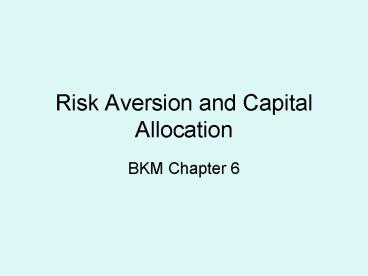BKM Chapter 6 - PowerPoint PPT Presentation
1 / 27
Title:
BKM Chapter 6
Description:
... of individual assets within each asset class, e.g., MSFT, IBM in the stock portfolio. ... sc=0.0*0.22= Borrow at the Risk-Free Rate and invest in stock. ... – PowerPoint PPT presentation
Number of Views:232
Avg rating:3.0/5.0
Title: BKM Chapter 6
1
Risk Aversion and Capital Allocation
- BKM Chapter 6
2
Risk Aversion Utility
- Investors view of risk
- Risk Averse
- Risk Neutral
- Risk Seeking
- Utility
- A measure of investor welfare based on the risk
and return of the investments. - Utility Function
- U E ( r ) - 0.5 A s 2
- Where A is the coefficient of risk aversion, a
measure of the degree of risk aversion. - Question Does a large A stand for a great or
small degree of risk aversion?
3
Utility Values for Investors with Different
Degree of Risk Aversion
- U E ( r ) - .5 A s 2
- 0.22 - .5 A (0.34) 2
- Risk Aversion A Value
- High 5 -0.069
- 3 0.0466
- Low 1 0.1622
T-bill 0.05
4
Comparing Utilities for Different Investments
- Which portfolio should investors choose?
- It depends on A!
5
Dominance Principle
Expected Return
4
2
3
1
Variance or Standard Deviation
Choices under Mean-Variance Criterion 2 v.s. 1
2 v.s. 3 4 v.s. 3 2 v.s. 4
6
Utility and Indifference Curves
- Represent an investors willingness to trade-off
return and risk. - An Example Utility Values of Possible Portfolios
for an Investor with Risk Aversion, A 4
7
Indifference Curves
Expected Return
Increasing Utility
Standard Deviation
8
Top-down Portfolio Construction Process
- Capital Allocation
- Allocation between the risk free asset and a
risky portfolio (from now on, the proportion on
risky portfolio is denoted as y). - Asset Allocation
- Choice of risky asset classes within the risky
portfolio, i.e., bonds, stocks, and real estates,
etc. - Security Selection
- Choice of individual assets within each asset
class, e.g., MSFT, IBM in the stock portfolio.
9
Allocating Capital Risky Risk Free Assets
- Suppose there is a complete portfolio of
300,000, with 30 in risk free asset, and the
remaining in a risky portfolio. The risky
portfolio invests 54 in equity (E) and 46 in
bond (B). What are the weights of E and B in the
complete portfolio? - wE/C y wE 70 54
- wD/C y wD 70 46
10
Expected Return and Variance for Combinations of
One Risky and a Risk-free Asset
11
Example Using Chapter 6.4 Numbers
12
Combinations Without Leverage
- When y0.75
- E(rc)0.750.150.250.07
- sc0.750.22
- When y1
- E(rc)1.00.1500.07
- sc1.00.22
- When y0
- E(rc)0.00.151.00.07
- sc0.00.22
13
Capital Allocation Line with Leverage
- Borrow at the Risk-Free Rate and invest in stock.
- Using 50 Leverage, i.e., y1.5, 1-y-0.5
- rc (-.5) (.07) (1.5) (.15)
- ?c (1.5) (.22)
14
Figure 6.4 The Investment Opportunity Set with a
RiskyAsset and a Risk-free Asset in the Expected
Return Standard Deviation Plane
15
CAL (Capital Allocation Line)
- Mathematical representation of CAL
- scysp
- y sc/sp
- E(rc) yE(rp) (1 - y)rf
- rf y(E(rp) rf)
- rf y(E(rp) rf)
16
CAL (Capital Allocation Line)
- Mathematical representation of CAL
- Is the slope of the CAL, also know as the
reward-to-variability ratio.
17
Figure 6.5 The Opportunity Set with Differential
Borrowing and Lending Rates
18
Utility Function and Capital Allocation
- U E ( r ) - .5 A s2
- Where
- U utility
- E ( r ) expected return on the asset or
portfolio - A coefficient of risk aversion
- s2 variance of returns
- In the case of allocation, we need to choose a y
so that U is maximized
19
Utility Function and Capital Allocation
- Recall
- E(rc) rf y(E(rp) rf)
- sc2y2 sp2
- Therefore
- U E (rC) - .5 A sC2
- rf y (E(rp) rf) 0.5 Ay2 sp2
- To maximize U, we need two conditions
- First order derivative w.r.t. y is zero
- Second order derivative w.r.t. y is negative
20
Utility Function and Capital Allocation
- First derivative w.r.t y
- Second derivative w.r.t. y
21
Utility Function and Capital Allocation
- From first condition, we obtain
- Observations
- Greater levels of risk aversion lead to larger
proportions of the risk free rate. - Lower levels of risk aversion lead to larger
proportions of the portfolio of risky assets.
22
Utility Function and Capital Allocation
- Example
- Rf7, E( rP )15, sP22, A4
- What is the optimal allocation?
23
Table 6.5 Utility Levels for Positions in Risky
Assets for an Investor with Risk Aversion A 4
24
Figure 6.6 Utility as a Function of Allocation to
the Risky Asset, y
25
Utility Function and Capital Allocation
26
CAL and Risk Preferences
E(r)
The lender has a larger A when
compared to the borrower
P
Borrower
7
Lender
?
?p 22
27
Assignments
- Chapter 6
- Problems 1-2, 7-11, 13-15, 17, 18, 23, 24, 30-33.































